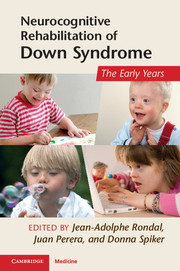Book contents
- Frontmatter
- Contents
- List of contributors
- Preface
- Acknowledgments
- Section 1 Definition, history, methodology, and assessment
- Section 2 Genetics, brain, and animal models
- Section 3 Pharmacological and medical management and treatment
- Section 4 Early development and intervention
- 10 Developmental models as frameworks for early intervention with children with Down syndrome
- 11 Aspects of motor development in Down syndrome
- 12 Memory development and learning
- 13 Prelinguistic and early development, stimulation, and training in children with Down syndrome
- 14 Speech perception, stimulation, and phonological development
- 15 Goal-directedness as a target for early intervention in Down syndrome
- 16 The role of parents of children with Down syndrome and other disabilities in early intervention
- Section 5 Therapeutic perspectives
- Conclusions
- Index
- References
15 - Goal-directedness as a target for early intervention in Down syndrome
Published online by Cambridge University Press: 05 July 2011
- Frontmatter
- Contents
- List of contributors
- Preface
- Acknowledgments
- Section 1 Definition, history, methodology, and assessment
- Section 2 Genetics, brain, and animal models
- Section 3 Pharmacological and medical management and treatment
- Section 4 Early development and intervention
- 10 Developmental models as frameworks for early intervention with children with Down syndrome
- 11 Aspects of motor development in Down syndrome
- 12 Memory development and learning
- 13 Prelinguistic and early development, stimulation, and training in children with Down syndrome
- 14 Speech perception, stimulation, and phonological development
- 15 Goal-directedness as a target for early intervention in Down syndrome
- 16 The role of parents of children with Down syndrome and other disabilities in early intervention
- Section 5 Therapeutic perspectives
- Conclusions
- Index
- References
Summary
Goal-directedness as a target for early intervention in Down syndrome
In discussing the notion of temperament, Wachs (1999) proposes that it is best viewed as a fuzzy set or a hybrid class. He explains that behaviors that are considered to be at the core of the notion of temperament are also considered integral to other areas of development. Wachs (1999) identifies temperament components such as attention skills and goal-directed behavior as critical to many of the leading theories of temperament, but he also notes that attention and goal-directed behavior are discussed as foundational to conceptualizations of other domains of development, such as cognitive development and motivation orientation.
The notion of temperament as a fuzzy set may be of particular interest to research on the emergence of the Down syndrome (DS) behavioral phenotype, and is of great clinical relevance for individuals with DS as well. This is because the early development of goal-directed behavior, one of the two overlapping constructs identified by Wachs (1999), may follow an atypical course in DS (Fidler, 2006). The fact that goal-directed behavior may be foundational to several different developmental domains means that atypical development in this area may have far reaching downstream effects in many different areas of functioning.
While work to uncover the developmental pathway is still quite preliminary, there is evidence that individuals with DS may show a disruption in the development of goal-directed behavior, manifested in the form of difficulties with problem solving and instrumental thinking throughout childhood.
- Type
- Chapter
- Information
- Neurocognitive Rehabilitation of Down SyndromeEarly Years, pp. 191 - 204Publisher: Cambridge University PressPrint publication year: 2011
References
- 8
- Cited by



